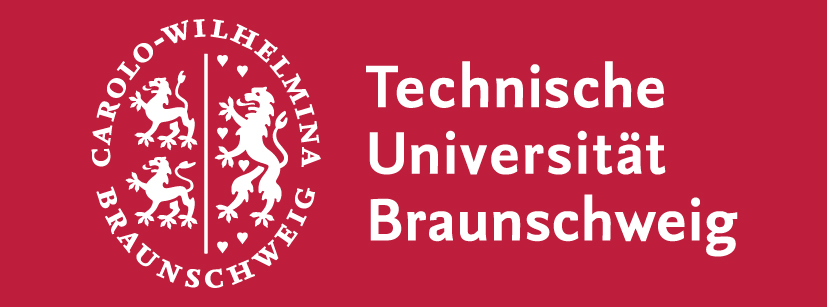Actually published

RECALLS - RECONSTRUCTIONS - PROJECTIONS
_Timebased Design Processes in Architecture
How can architecture intervene in challenging situations? How
can it influence social dynamics and give rise to new forms of
activity? What are the methods, tools, and media that it uses
and what roles do they play in generating new knowledge?
Taking these questions as its starting point, the volume explores
the potential of architectural design to disrupt and transform
existing systems and contexts by employing technical, aesthetic,
and symbolic practices and visualization techniques. The
development of new time-based media of investigation, imagination,
and cooperation renders design eminently suitable for initiating
actions of transgression, resistance, and collective participation.
Based on these considerations, the volume sheds light on design
viewed as a critical spatial practice, knowledge creation, and form
finding. The theoretical and practical contributions gathered here
open up a variety of content-led and methodological approaches
to the still-young field of media-cultural and architectural design
research.
With essays by Carolin Höfler, Matthias Karch, Kassandra Nakas,
and Philipp Reinfeld as well as case studies of designs, conceptual
sketches, performative realizations, and built structures by
students of the IMD _Institute of Media and Design.
RECALLS – RECONSTRUCTIONS – PROJECTIONS
Editors: Carolin Höfler and Matthias Karch
336 pages
Hardcover
175 x 303mm
ISBN 978-3-910265-20-2
Verlag SORRY PRESS, München
29.- €
Direct order via:
https://www.sorry-press.com
________________________________________________________________________________
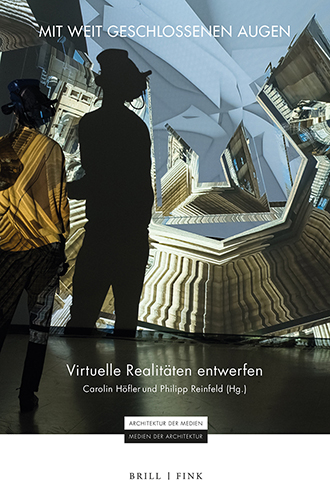
MIT WEIT GESCHLOSSENEN AUGEN _Virtuelle Realitäten entwerfen
Der Band geht aus einer interdisziplinären Tagung hervor, die an der Köln International School of Design der Technischen Hochschule Köln in Kooperation mit dem Institute of Media and Design der Technischen Universität Braunschweig durchgeführt wurde.
Zum Inhalt: Bis heute gilt die realitätsgetreue Darstellung als Ausweis gelungener Virtual-Reality-Umgebungen. Doch von welchen real-virtuellen Realitäten ist hierbei die Rede, was zeichnet sie aus, und worin unterscheiden sie sich von perspektivischen Bildräumen? Diese Fragen bilden den Ausgangspunkt für neun grundlegende Beiträge, in denen sich Forscher:innen aus theoretischer und methodologischer sowie empirischer, historischer und systematischer Perspektive mit Phänomenen der virtuellen und erweiterten Realität in Medien, Künsten, Gesellschaft und Politik befassen. Sie zeigen, wie Virtual-Reality-Technologien Raumerfahrung und Selbstwahrnehmung verändern und welche Auswirkungen die einhergehende Grenzaufhebung von Bild und Körper für das Entwerfen in Architektur und Design haben werden.
Herausgeber*innen: Carolin Höfler und Philipp Reinfeld
Mit Beiträgen von: Marc Bonner, Stephan Günzel, Lilian Haberer, Carolin Höfler, Eike Langbehn, Philipp Reinfeld, Lasse Scherffig, Jens Schröter, Lambert Wiesing
Reihe: Architektur der Medien – Medien der Architektur, Band: 1
Verkaufspreis: [DE] 49,90 €
Link zur Verlagsseite: BRILL FINK Verlag
________________________________________________________________________________
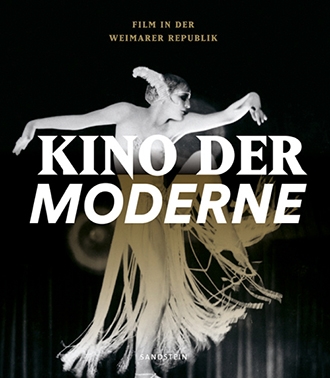
KINO DER MODERNE. Film in der Weimarer Republik, Ausst.kat., hrsg. v. Kunst- und Ausstellungshalle der Bundesrepublik Deutschland, Bonn; Deutsche Kinemathek, Berlin. Dresden: Sandstein 2018. [mehr]
________________________________________________________________________________
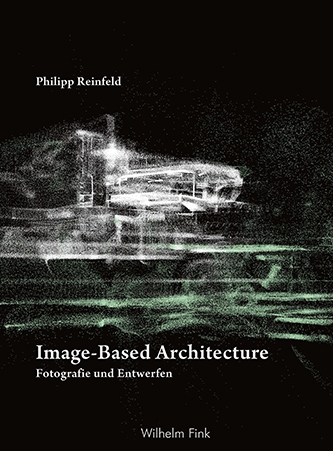
Philipp Reinfeld:"Image-Based Architecture. Fotografie und Entwerfen"
Wilhelm Fink, Paderborn, 2018
Welches entwurfliche Potenzial bergen fotografische Bilder, wenn sie als aktives Medium architektonischer Raumproduktion verwendet werden? Mit der massenhaften Verbreitung von Kameratechnik im Smartphone hat sich die „Amateurfotografie“ in den letzten Jahren mehr und mehr zu einer eigenen Kommunikationsform gewandelt. Der fotografische Zugang zur Welt zielt heute weniger auf die Bezeugung von etwas vormals Geschehenem ab als vielmehr auf eine laufend sich wiederholende, visuelle Veräußerung eigenen Handelns im „Hier und Jetzt“. In gleicher Weise wie frühere Formen bildlich-perspektivischer Raumrepräsentationen Einfluss hatten auf die Konstitution räumlicher Gestaltgebung, beginnen auch die neuen fotografischen „Bildwelten“ die Architekturproduktion im Sinne eines Übersprungs bildlicher Logik in räumliche Materialisierungen spezifisch zu bestimmen. Auf Grundlage einer medientheoretischen Einordnung historischer wie aktueller Wechselwirkungen zwischen Kamerabildern und Raumgestaltung werden Strategien vorgestellt, wie die Fotografie sich zu einem Medium des architektonischen Entwerfens entwickeln lässt. Eine Vielzahl experimenteller Projektbeispiele, die im Rahmen einer forschenden Lehre am Institut für Mediales Entwerfen der TU Braunschweig entstanden sind, werden den theoretischen Betrachtungen zur Seite gestellt.
________________________________________________________________________________
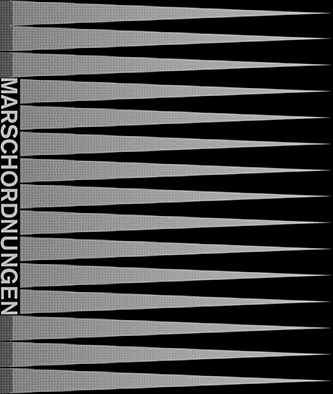
Marschordnungen. Das Reichsparteitagsgelände in Nürnberg / March Formations. The Nazi Party Rally Grounds in Nuremberg
Katalogband zur gleichnamigen Ausstellung / catalogue to the exhibition, hg. v. / ed. by Carolin Höfler und / and Matthias Karch, Berlin 2016, 180 S.
ISBN 978-3-00-052654-1
15,-- €
________________________________________________________________________________
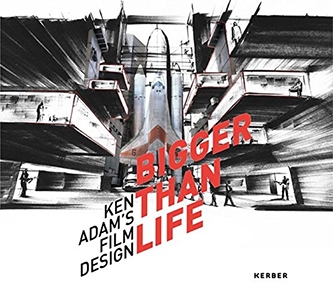
Carolin Höfler und Matthias Karch: „Ken Adams Modelle des Denkens - Handzeichnungen und Kopfräume“. Beitrag im Katalog BIGGER THAN LIFE. Ken Adam's Film Design. Mit einem Vorwort von Daniel Libeskind _KERBER Verlag, Dezember 2014
'Die Filmsets von Ken Adam haben meine Vorstellungskraft ganz entscheidend entfacht. Nicht, dass ich sagen würde ‚Ich baue jetzt das Set von James Bond nach… Aber die Welt von Ken Adam hat meine Erwartungen an Raum, Licht und Farbe in der Architektur ganz einfach auf ein anderes Niveau erhoben.' _Daniel Libeskind.
Order the BIGGER THAN LIFE catalogue here
________________________________________________________________________________
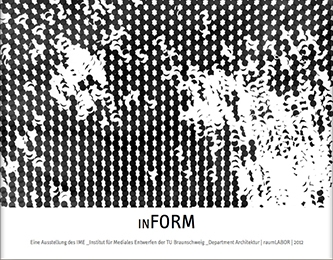
Christophe Barlieb, Carolin Höfler, Matthias Karch, Katharina Puhle, Philipp Reinfeld: inFORM. An Exhibition of the Institute of Media Design from the Technical University of Braunschweig, Braunschweig, raumLABOR at the University of Arts, 2012.
The exhibition catalogue offers insight into the institute’s conceptual and methodical principles of operation. The projects illustrated in text and images refer to visual and spatial "findings", in which systems and processes unfold. The discovered materials include graphic code structures and geographically referenced photographs in the Internet to everyday object arrangements to the sphere of urban mobility. The drawings and objects emerge from the collected information to form new worlds, which follow a specific set of rules. They have a double meaning as "in-formation": they contain information and inform them. The exhibition presents pictures and models, in which information structures are transformed into architectural spaces. This approach is aimed at the defining a dynamic architecture, complex systems, manifested in forms to be perceived by human senses. [more]
________________________________________________________________________________
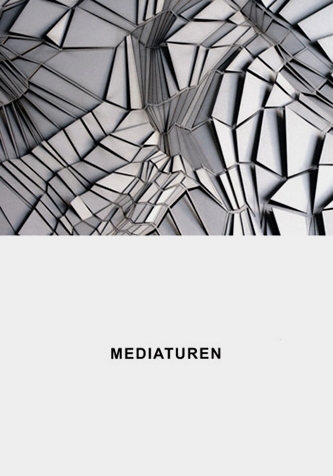
Carolin Höfler: Mediaturen. Ausstellungskatalog, Architektur Galerie Berlin, werkraum, 17.07.-16.08.2008.
Mediaturen is a concept of art and consists of the words Media and architecture. The concept emphasizes the reciprocal operating relationship between design and media and refers to the process-like character of the architecture. The catalog of the exhibition Mediaturen in the Architecture Gallery Berlin provides an insight into the teaching of experimental design at the Institute of design, media and presentation at the Technical University of Brunswick and displays student work, which originated in the dialectical process between analog and digital design. In ten chapters, the work will be characterized by terms and procedures that have not been significant or not relevant in architectural theory or design. Concepts such as line, surface area and space or section cut, layer and edge are influenced by scientific and cultural ideas of modern information technology and alter its importance. Against this background, the question to be asked is how the digital has changed the discussion and design of architecture. [more]
________________________________________________________________________________
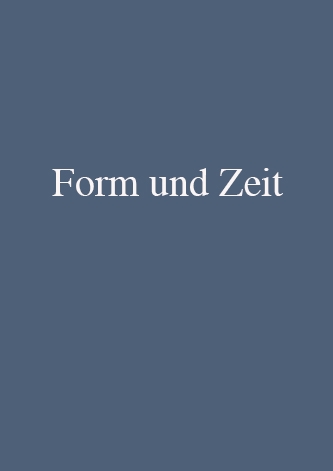
Carolin Höfler: „Form und Zeit“, 2009 Dissertation Form und Zeit. Computerbasiertes Entwerfen in der Architektur bei Prof. Dr. Horst Bredekamp (summa cum laude).
"Without question, the computer in the nineties of the 20th century has become the ever-present infrastructure of contemporary architectural production, but that does not mean that it has become an undisputed condition. Until now the computer has been used as a tool for efficient plan drawing, however, the design concepts being based on sketches and analog models. Also with respect for the possibility of the three-dimensional visualization of the design, which allows spatial presentations either as supplement or even replacement to model building, the use of the machine has become and will especially be seen for the acceleration of the design process. The use of the computer has reached a new phase with its instrumentalization of architectural form-finding and production.
The guided discussion of this moment over the advantages and disadvantages of handwork and technical design and presentation processes divides architects and commentators in opposition to this day. The discussions at German Architecture faculties over the subjects of drawing and painting, sculptural design and computer aided design and manufacturing remind in their polarity the debates between the different directions of modern architecture. Technical media and methods will be linked up to this meaning, which were attributed to the geometric-abstract, rectangular shape formation in the twenties and sixties of the 20th Century, whereas manual procedures with notions of the free form generation are associated. On the one hand, the critics of digital tools and products identify computer design with reduction, monotony, reproducibility and randomness while hand drawing and modeling is held as an expression of spontaneity, imagination, physicality and individual freedom. The alternative computer versus drawing debate leads to the usual pairs of opposites such as technical versus handwork product, rational versus free form, intangible versus intangible. With these additions, the technical processes and products are defined by accepted shortcomings and fixed on characteristics, which are based on prejudice. On the other hand, many computer architects are met by euphoria for the new design and manufacturing tools, which is reminiscent of the technically grounded utopias of the modern architects with regard for new building materials and procedures. With their declaration of the end of handwork and the beginning of a new academic architecture they follow the ideas of dogmatic modernism and it's principle of either-or, which has already established a naive functionalism and orthodox rationalism and for them Architecture as a sense-perception appealing art form in a special way was destroyed. With this dichotomous classification of design media, insurmountable contrasts between the different practices and products are built, which will not play a role in the contemporary, experimental design work and the design results..."
